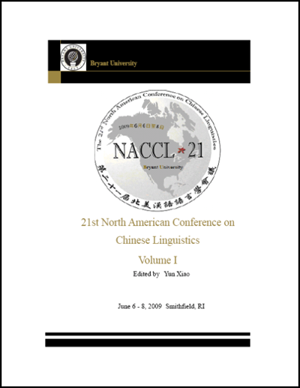NACCL Proceedings Online — NACCL-21 (2009)
Proceedings of the 21st North American Conference on Chinese Linguistics (NACCL-21). 2 Volumes. 2009.
Edited by Yun Xiao.
Published by Bryant University, Smithfield, Rhode Island.
Distributed by NACCL Proceedings Online, The Ohio State University, Columbus, Ohio.
 |
The NACCL-21 Proceedings is available here in PDF format. (Note: Adobe Reader (formerly, Acrobat Reader) version 6.0 or higher is required. The full-text PDF files open in a new window.)
- Download the NACCL-21 Proceedings as two PDF files here:
Volume 1 (4.5 MB) -- Volume 2 (4 MB). - To download individual papers from the two volumes, see below.
Volume 1
- Cover for Volume 1
- Front pages for Volume 1 (pp. i - vi)
(copyright page, table of contents for volume 1, preface, acknowledgment and NACCL Conferences, 1989-2009) - NACCL-21 Papers: Part 1 (pp. 1 - 27)
- Invited Papers (Numbered 1 to 2)
- Download the full-text PDF files below. - NACCL-21 Papers: Part 2 - Part 4 (pp. 28 - 208)
- Main Session Papers (Numbered 2 to 15)
- Download the full-text PDF files below.
Volume 2
- Cover for Volume 2
- Front pages for Volume 2 (pp. i - iii)
(copyright page and table of contents for volume 2) - NACCL-21 Papers: Part 5 - Part 6 (pp. 209 - 600)
- Main Session Papers (Numbered 16 to 39)
- Download the full-text PDF files below.
Part 1. Invited Papers (1 - 2)
- Yen-Hwei Lin
Loanword adaptation and phonological theory (p. 1) - Hongyin Tao
Core vocabulary in spoken Mandarin and the integration of corpus- based findings into language pedagogy (p. 13)
Part 2. Phonetics and Phonology (1 - 10)
- Yufen Chang
The phonology of ABB reduplication in Taiwanese (p. 28) - Yen-Chen Hao
Tonal adaptation of English loanwords in Cantonese (p. 42) - Ting L. Huang
Prosodic influences on Chinese tongue twisters (p. 55) - Chien-Hui Lee
The reconstruction of sk- and kr- clusters about Fang Kuei Li (p. 65) - Yu-Leng Lin
Tests of analytic bias in native Mandarin speakers and native southern Min speakers (p. 81) - Hsiu-Hsueh Liu 劉秀雪
漢語鼻尾小稱與詞根的互動 (p. 93) - Chin-Wei Wu
Partial-reduplication with fixed segmentism in Chinese dialects—An Optimality Theory Approach (p. 108) - Huili Zhang 张慧丽
偃师方言的儿化及相关问题 (p. 120)
Part 3. Studies in Language Acquisition (11 – 14)
- Agnes Weiyun He
Conversational repair: Where modality and morality converge (p. 138) - Jidong Chen and Ruixi Ai
Encoding motion and state change in L2 Mandarin (p. 149) - Po-Ting Chen
Topic and topic-comment structures in first language acquisition of Mandarin Chinese (p. 165) - Hsiang-Ting Andrea Wu
Roles of pictures and native language in lexical processing for elementary American learners (p. 178)
Part 4. Study in Historical Linguistics (15)
- Jung-Im Chang
Grammatical changes reflected in the chapters "Yaodian" (堯典) and "Gaoyao mo" 皋陶謨 in the Shangshu (尚書) and relevant chapters in Shiji 史記 (p. 196)
Part 5. Semantics and Syntax: A Functional Approach (16 – 29)
- Liang Tao
Serial verb construction in Mandarin Chinese: The interface of syntax and semantics (p. 209) - Tao Ming
Grammatical roles of the head noun in Chinese relative clauses (p. 229) - Hui Cao
Discourse-oriented distributivity in Mandarin Chinese (p. 247) - Xiao-Qin Deng 邓小琴
香港粤语入文变异研究1: 以香港报刊杂志语言使用为例 (p. 256) - Chin-Man Kuo
The meaning of S-topics in Mandarin: A crosslinguistic comparison (p. 271) - Pei-Jung Kuo
Possessor raising and BA construction (p. 291) - Zanhui Huang and Yan Jiang
The function of měi in měi-NPs (p. 304) - Ni Eng Lim
Stance-taking with Wo Jue De in conversational Chinese (p. 323) - Wan-Hua Lin
Preferred argument structure in Chinese: A comparison among conversations, narratives and written texts (p. 341) - Binmei Liu
Chinese discourse markers in oral speech of mainland Mandarin speakers (p. 358) - Tom McClive
Romanization patterns in Chinese as evidenced by a personal name corpus (p. 375) - Fei Ren
Aspect and modality of yinggai (p. 388) - Juan Wang
A corpus-based study on the Chinese near-synonymous verbs of running (p. 399) - Hui Zhang 张慧
现代汉语非宾格结构的内部句法差异 (p. 417)
Part 6. Studies in Generative Grammar (30 – 39)
- Y.-H. Audrey Li and Shi-Zhe Huang
Looking into clauses (p. 436) - Hsiang-Yun Chen
Logophoricity and ziji (p. 464) - Hsu-Te Johnny Cheng
Right node raising: Some perspectives from Mandarin Chinese (p. 482) - I-Ta Chris Hsieh
Even-focus and VP-fronting in Mandarin Chinese (p. 494) - Rui-heng Ray Huang
Resolving a subject-object asymmetry with respect to existential polarity Wh-phrases (p. 508) - Xiao-You Kevin Huang
Multiple-modal constructions in Mandarin Chinese: A cartographic approach and an MP perspective (p. 524) - Chao Li
Argument realization: Particularities and universals (p. 541) - Grant Xiaoguang Li
Distributivity in ellipsis in Chinese (p. 553) - Kening Li
An OT analysis of informational focus in Mandarin Chinese (p. 566) - Lyn Shan Tieu
Standard vs. sideward movement in verb copying (p. 584)
